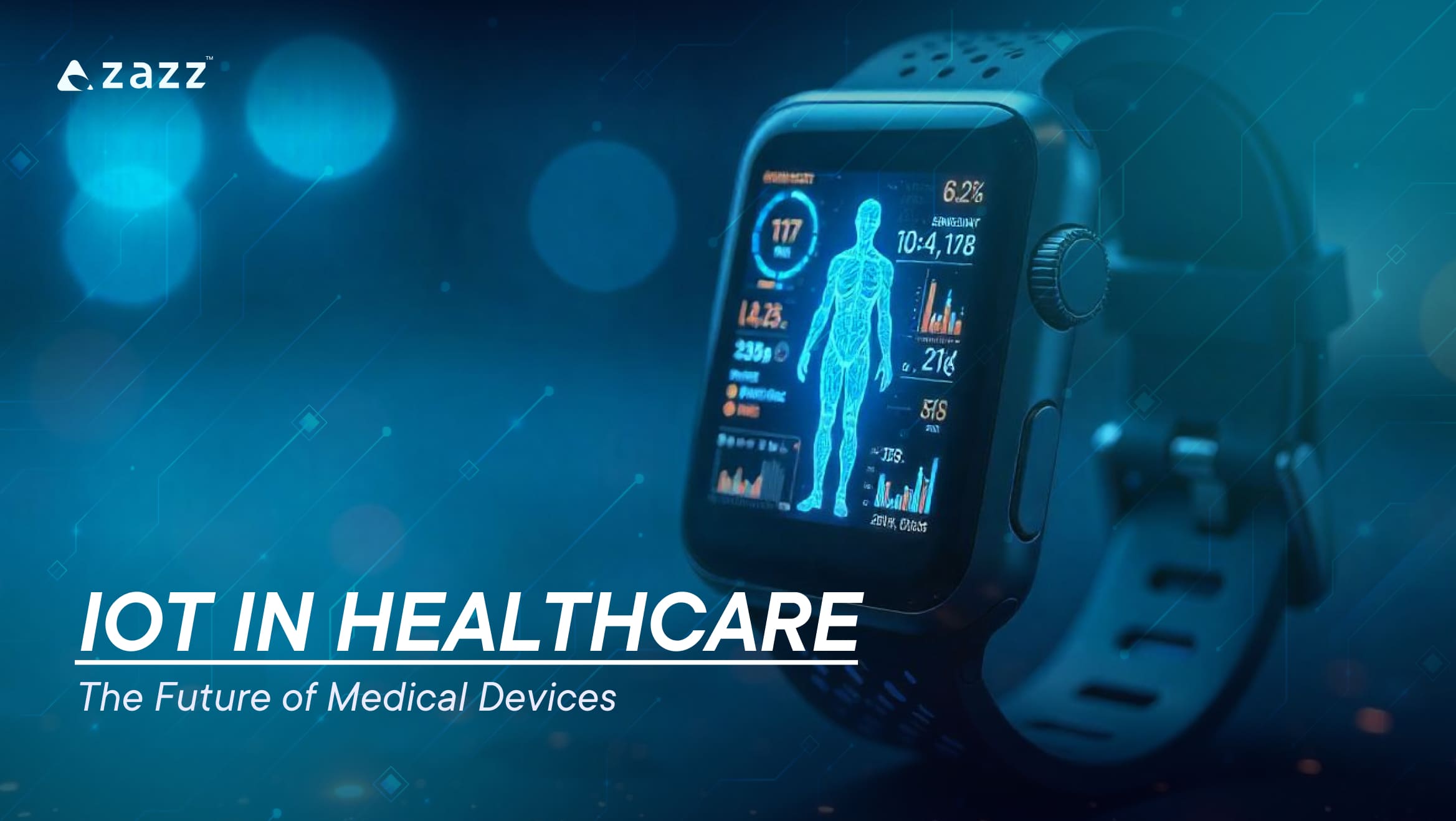
The Internet of Things (IoT) is reshaping every industry, and healthcare is no exception. As we approach 2025, the IoT in healthcare is poised to revolutionize the way medical professionals monitor, diagnose, and treat patients. By connecting devices, sensors, and systems, IoT technology in healthcare promises to deliver smarter, more efficient, and personalized care that can improve patient outcomes and streamline operations.
In this blog, we will explore how IoT is transforming the healthcare industry, the benefits of IoT in healthcare, the challenges associated with its adoption, and the future of IoT applications in healthcare in 2025.
The Rise of IoT in Healthcare: A Game-Changer for the Industry
The term IoT in healthcare refers to the integration of interconnected medical devices, sensors, and applications that communicate with one another to collect, share, and analyze healthcare data. These technologies offer real-time monitoring, automated data collection, and insights that support proactive healthcare management, ultimately enhancing patient care.
As healthcare systems evolve to meet the demands of a growing, aging population, IoT is playing an increasingly critical role in improving healthcare efficiency and accessibility. In the coming years, IoT technology in healthcare will be pivotal in enabling a more patient-centric approach by allowing healthcare providers to offer personalized treatments, monitor patient conditions remotely, and prevent health complications before they arise.
Related reading: Internet of Things: Threats and Security Challenges to Overcome
5 Key IoT Applications in Healthcare
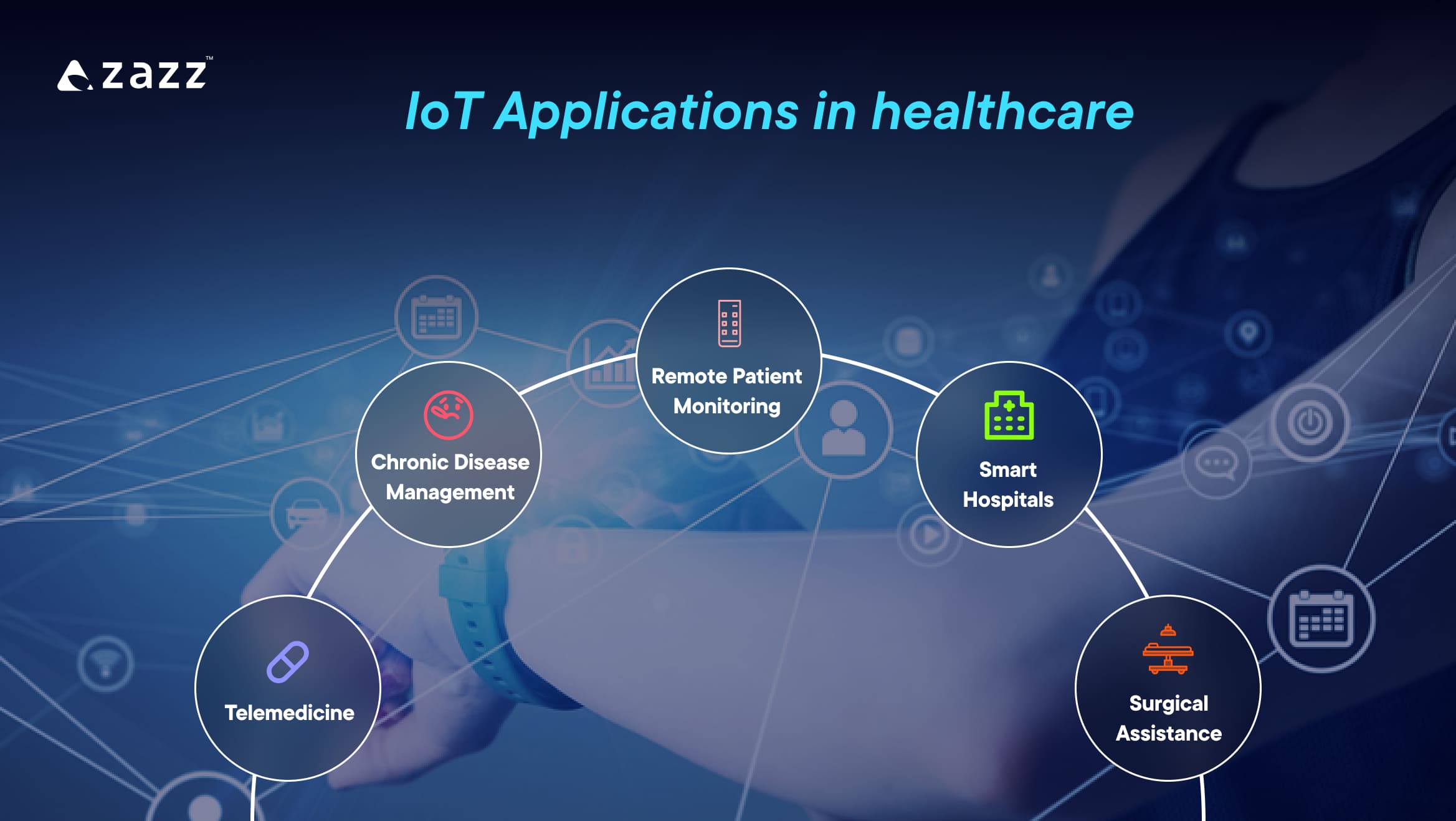
IoT applications in healthcare are vast and varied. From IoT medical devices to telemedicine solutions, there are many ways that IoT in healthcare is improving patient outcomes. Some of the key areas where IoT is making an impact include:
1. Remote Patient Monitoring
One of the most significant benefits of IoT in healthcare is the ability to remotely monitor patients’ vital signs and chronic conditions. Wearables like smartwatches and fitness trackers are designed to collect and transmit data such as heart rate, oxygen levels, and blood pressure. This real-time data can be shared with healthcare professionals, allowing them to intervene quickly if any abnormalities are detected.
2. Smart Hospitals
IoT technology in healthcare is enabling the development of smart hospitals. These hospitals use interconnected systems and devices to monitor patients, manage resources, and improve operational efficiency. Smart beds that track a patient’s movement, wearable devices that monitor vital signs, and automated systems for managing patient flow are just a few examples of IoT applications in the healthcare sector.
3. Telemedicine
Telemedicine, supported by IoT devices, allows healthcare professionals to conduct remote consultations with patients. IoT in healthcare ensures that real-time monitoring tools, such as blood pressure cuffs and glucose meters, can transmit data directly to a doctor during a virtual consultation, enabling more accurate diagnoses and timely treatment.
4. Chronic Disease Management
IoT applications in healthcare are especially valuable for the management of chronic diseases such as diabetes, hypertension, and cardiovascular conditions. Devices that monitor blood sugar levels, blood pressure, and other health metrics continuously provide healthcare providers with vital information, allowing them to adjust treatment plans and intervene when necessary.
5. Surgical Assistance
IoT medical devices are also enhancing the precision of surgical procedures. Devices that track instruments, monitor patient vitals, and provide real-time data can improve surgical outcomes. Additionally, IoT in healthcare facilitates the integration of augmented reality (AR) and artificial intelligence (AI) into surgeries, providing surgeons with enhanced guidance during procedures.
Transform how healthcare is delivered with the latest IoT innovations. Whether it’s remote monitoring or real-time diagnostics, Expert developers at Zazz can help you create state-of-the-art IoT healthcare applications. Contact us today to start your journey toward smarter, connected healthcare solutions.
Related reading: What Is Interoperability in Healthcare? Complete Guide
Top 5 Benefits of IoT in Healthcare
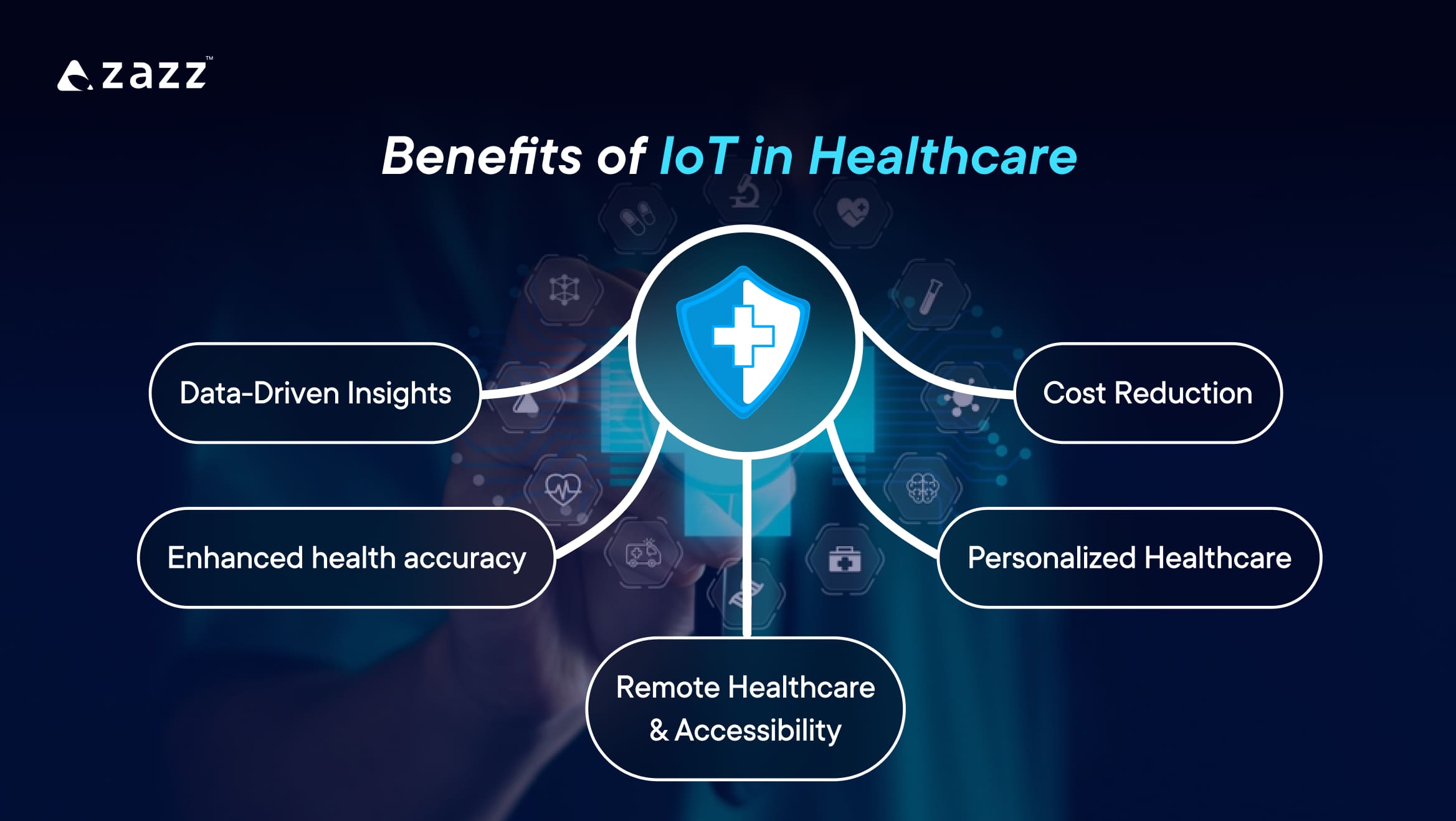
The benefits of IoT in healthcare are numerous and transformative. These advantages contribute to improved patient outcomes, operational efficiency, and reduced healthcare costs. Below are some of the key IoT benefits in healthcare:
1. Enhanced health accuracy:
IoT-enabled devices ensure continuous monitoring, providing real-time data that improves the accuracy of diagnoses and the timing of interventions. With early detection of potential health issues, patients can receive timely care, which can lead to better health outcomes and reduce hospital readmission rates.
2. Personalized Healthcare:
One of the biggest advantages of IoT in healthcare is the ability to provide personalized care. By collecting data from various sources, healthcare providers can tailor treatments to individual patients, taking into account their unique health profiles and preferences. This individualized approach improves the effectiveness of treatments and promotes a better patient experience.
3. Cost Reduction:
The integration of IoT in healthcare can lead to significant cost savings. By streamlining patient monitoring and improving operational efficiency, healthcare providers can reduce administrative costs, prevent unnecessary hospital visits, and avoid readmissions. Additionally, preventive care, supported by continuous monitoring, can reduce the need for expensive emergency interventions.
4. Remote Healthcare and Accessibility:
IoT in healthcare enables remote healthcare delivery, making medical care more accessible to people living in rural or underserved areas. By utilizing wearable devices and remote monitoring tools, healthcare providers can keep track of patient health without requiring them to visit the hospital physically. This improves access to care and reduces the burden on healthcare facilities.
5. Data-Driven Insights:
IoT devices collect large amounts of real-time data, providing valuable insights into patient health trends, treatment efficacy, and overall healthcare system performance. These insights can be used to optimize healthcare delivery, improve patient outcomes, and drive innovation in medical research.
Challenges of IoT in Healthcare
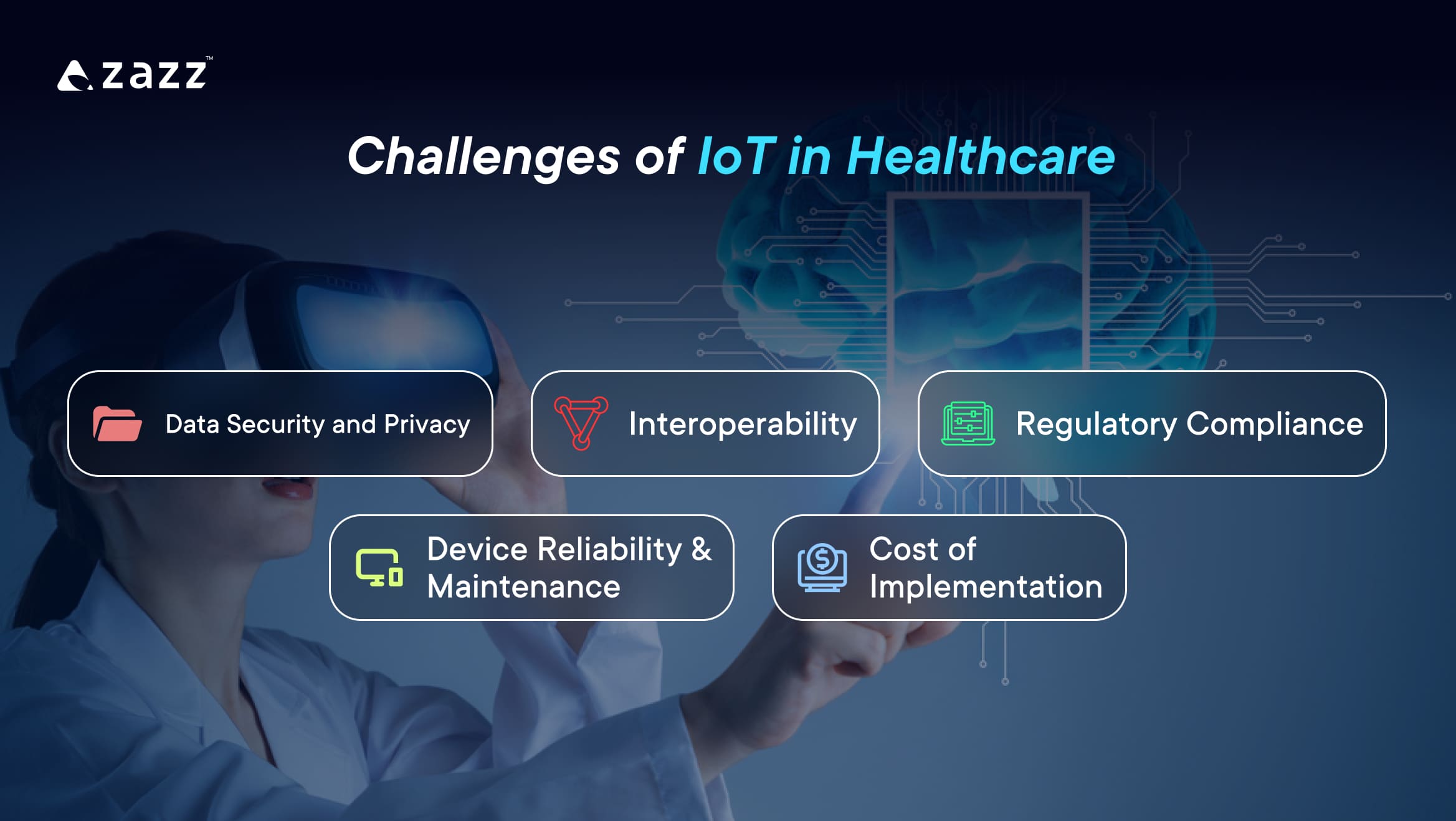
While the benefits of IoT in healthcare are significant, the implementation of IoT in medical devices and healthcare systems comes with its own set of challenges. Below are some of the key IoT challenges in healthcare:
1. Data Security and Privacy:
One of the biggest concerns surrounding the adoption of IoT technology in healthcare is the security of sensitive health data. With more connected devices generating large volumes of personal health data, ensuring that this data is protected from cyberattacks and unauthorized access is paramount. Healthcare organizations must invest in robust cybersecurity measures to safeguard patient information.
2. Interoperability:
For IoT to be fully effective in healthcare, devices, applications, and systems must be able to communicate seamlessly with each other. However, many healthcare institutions still rely on outdated infrastructure and disparate systems that may not be compatible with newer IoT devices. Ensuring interoperability across different platforms remains a significant hurdle in the integration of IoT in healthcare.
3. Regulatory Compliance:
The healthcare industry is highly regulated, and IoT devices must meet strict standards to ensure patient safety and compliance with healthcare laws. Manufacturers must ensure their products adhere to regulatory guidelines such as the Health Insurance Portability and Accountability Act (HIPAA) in the U.S. and the European Union’s General Data Protection Regulation (GDPR).
4. Device Reliability and Maintenance:
As healthcare providers increasingly rely on IoT devices for patient monitoring and diagnostics, the reliability of these devices becomes critical. Regular maintenance and calibration are necessary to ensure that devices function correctly and provide accurate data. Developing a standardized process for device maintenance and ensuring reliability is a challenge faced by healthcare organizations adopting IoT technology.
5. Cost of Implementation:
While IoT devices can lead to cost savings in the long run, the initial investment required for the adoption of IoT in healthcare can be significant. Healthcare organizations must consider the costs of purchasing, implementing, and maintaining IoT devices and infrastructure. Smaller healthcare facilities, in particular, may find it challenging to justify these upfront costs.
Related reading: How can AI help reduce readmissions?
Enhance Patient Care with Custom IoT Solutions – Talk to Zazz Experts.
The Future of IoT in Healthcare
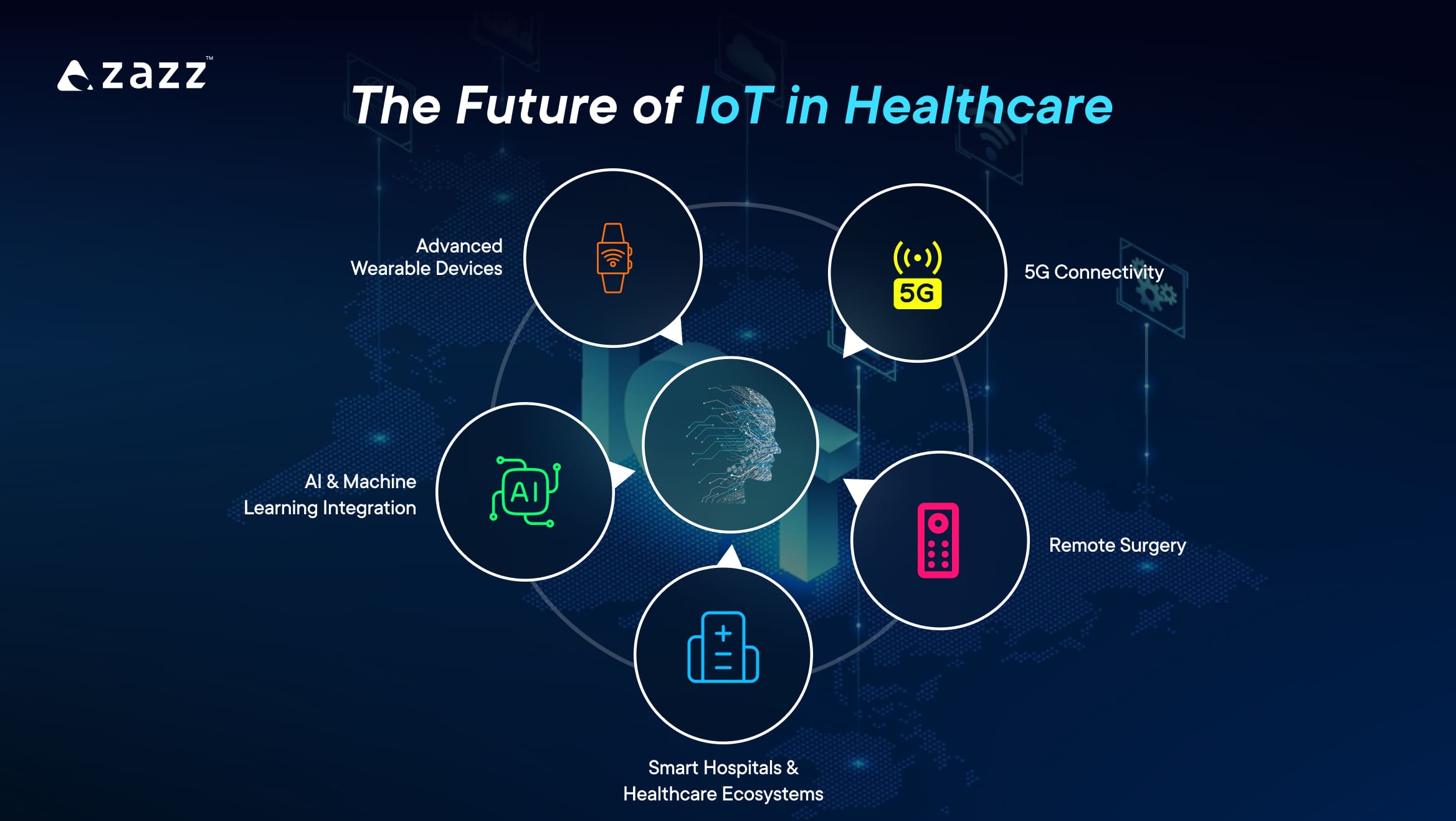
As we move toward 2025, the future of IoT in healthcare looks promising, with continued innovation and advancements in technology. Here’s what we can expect:
1. Advanced Wearable Devices
Wearable IoT devices are expected to become even more advanced, capable of tracking a wider range of health metrics. In the future, wearables may not only track vital signs but also detect diseases and conditions before symptoms appear. These devices will be crucial in preventative healthcare and chronic disease management.
2. 5G Connectivity
The arrival of 5G networks will significantly enhance IoT in healthcare, providing faster, more reliable communication between devices. This will improve real-time monitoring and telemedicine applications, allowing healthcare providers to deliver better care with minimal delays.
3. AI and Machine Learning Integration
The integration of artificial intelligence (AI) and machine learning (ML) with IoT technology in healthcare will enhance the predictive capabilities of devices. By analyzing real-time data from IoT devices, AI algorithms will help healthcare providers anticipate health issues and offer personalized treatment recommendations.
4. Smart Hospitals and Healthcare Ecosystems
By 2025, we can expect more healthcare facilities to adopt smart hospital technologies. IoT devices will work together to improve patient care, optimize resource allocation, and ensure that healthcare providers have the data they need to make informed decisions.
5. Remote Surgery
With the advancements in robotics and IoT, remote surgery could become more common. Surgeons will be able to perform complex procedures from a distance with the help of IoT-powered surgical tools and robotic systems.
Related reading: Software Architecture for Healthcare Apps
Conclusion
The IoT in healthcare industry is poised for massive growth by 2025, with new IoT medical devices and innovations transforming how we approach patient care, diagnosis, and treatment. The advantages of IoT in healthcare are clear—improved patient care, cost savings, and better data-driven insights—but the challenges of IoT in healthcare must also be addressed, including security, interoperability, and regulatory compliance.
The impact of IoT in healthcare will continue to grow as we move toward a more connected, patient-centric healthcare system. As these technologies evolve, the future of IoT in healthcare will be marked by greater accessibility, precision, and efficiency, creating a smarter healthcare ecosystem that benefits both patients and providers alike.
By 2025, the integration of IoT in healthcare will become an integral part of healthcare delivery, improving outcomes, reducing costs, and empowering patients and healthcare providers with real-time, actionable data. The healthcare industry is on the cusp of a digital revolution, and IoT is leading the charge.
Looking to develop a custom IoT healthcare application? Our team specializes in creating tailored solutions that empower healthcare providers and improve patient care. Get in touch with us to learn more about how we can help you develop the perfect IoT app for healthcare needs
Frequently Asked Questions
IoT app development in healthcare refers to the creation of mobile or web applications that integrate with Internet of Things (IoT) devices to monitor, track, and manage healthcare data in real time. These applications connect medical devices, wearables, sensors, and healthcare systems to gather and analyze data for improved patient care, diagnosis, and treatment outcomes.
IoT apps contribute to cost reduction in healthcare by automating monitoring processes, reducing unnecessary hospital visits, and preventing hospital readmissions through proactive care. By enabling remote patient management, IoT reduces the need for emergency interventions and in-person appointments, ultimately lowering healthcare costs while improving patient outcomes.
IoT apps facilitate remote healthcare by allowing patients to wear devices that track their health metrics and send data to healthcare providers in real-time. This enables telemedicine solutions, where doctors can monitor patients from a distance, adjust treatments, and provide timely interventions without the need for in-person visits.
IoT improves patient care by enabling continuous monitoring of vital signs such as heart rate, blood pressure, and glucose levels. This data is transmitted in real-time to healthcare providers, allowing for prompt action and more personalized treatment. IoT technology also empowers patients to take an active role in their health, improving overall care management and enhancing the patient experience.
The future of IoT in healthcare is incredibly promising, with advancements in wearable devices, smart hospitals, and connected health systems. We can expect even more integration of AI, machine learning, and predictive analytics into healthcare IoT apps, enhancing the precision of diagnoses and treatment plans. The development of 5G networks will also enable faster, more reliable real-time data exchange, making remote healthcare and telemedicine even more efficient.
The key benefits of using IoT in healthcare include:
- Real-time monitoring of patient health, reducing the need for frequent doctor visits.
- Improved patient outcomes through accurate and continuous health data tracking.
- Remote healthcare capabilities, enabling healthcare providers to assist patients from a distance.
- Operational efficiency, streamlining healthcare workflows and reducing costs.
- Predictive analytics, helping doctors anticipate health issues before they become critical.
Recent Articles
Table of Content 1. The Rise of IoT in Healthcare:...
Table of Content 1. 10 Essential features of travel app...
Table of Content 1. Choosing the Right EHR Software Features...












